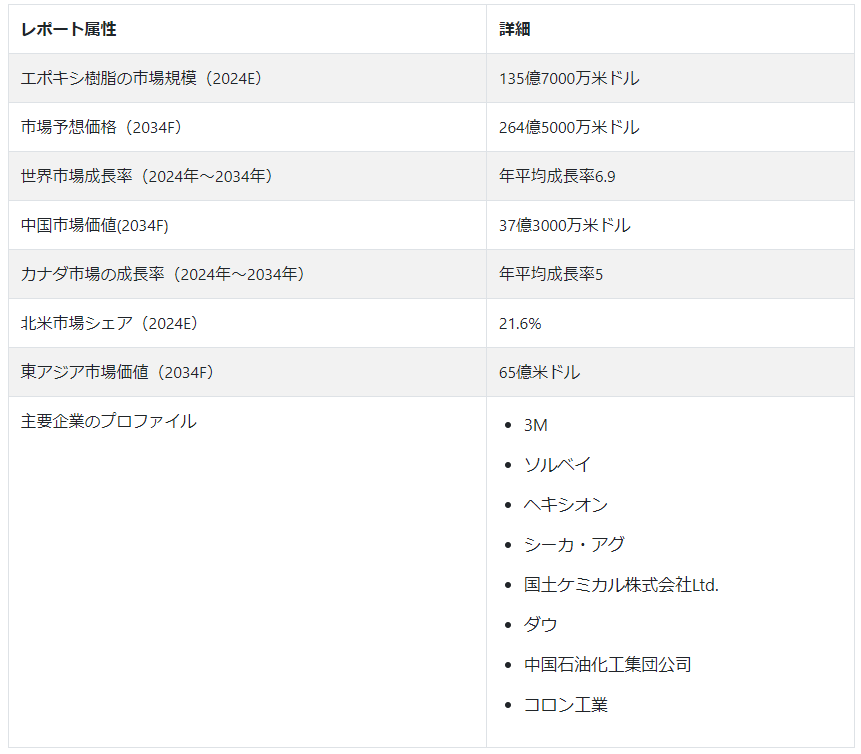エポキシ樹脂の世界市場2024-2034年:用途別(塗料、風力エネルギー、複合材料)、原材料別(DGBEA、DGBE、ノボラック)、地域別

※本ページに記載されている内容は英文レポートの概要と目次を日本語に自動翻訳したものです。英文レポートの情報と購入方法はお問い合わせください。
*** 本調査レポートに関するお問い合わせ ***
Fact.MRの最新業界分析によると、世界のエポキシ樹脂市場規模は2024年の135.7億米ドルから2034年には264.5億米ドルに達すると予測されている。この増加は、2024年から2034年までの予測CAGR 6.9%に相当する。
エポキシ樹脂は木材ラミネーション用の接着剤として一般的に使用され、床材、窓、屋根、壁、デッキなど様々な用途の建設業界で幅広い用途を見出している。建築における木材の使用の増加は、この分野におけるエポキシ樹脂の需要を促進すると予測されている。航空宇宙産業もまた、耐風性と航空機の全体的な重量の軽減を助ける複合部品の需要の増加により、エポキシ樹脂の用途の増加を目の当たりにしている。複合材料とエポキシ樹脂の優れた接着特性は、航空宇宙産業における需要をさらに増大させる。
風力エネルギー分野では、風力タービンや関連部品の製造に複合材料や繊維強化プラスチックの使用が増加している。エポキシ樹脂は、美術品、装飾品、キッチンのカウンタートップなど、他のさまざまな分野でも使用されており、市場の成長に寄与している。
建設や自動車分野、風力エネルギーや航空宇宙分野における軽量で高性能な材料への需要の増加は、予測期間を通じてエポキシ樹脂の需要を牽引すると予測されている。生分解性ポリマーへのニーズの高まりと、ビスフェノールAの使用を規制する厳しい環境規制が、予測期間中の需要拡大を妨げる可能性がある。同市場は現在、不飽和ポリエステル樹脂市場、脂肪族溶剤市場、その他の関連市場と並んで着実な市場成長を示している。
エポキシ樹脂の使用拡大につながっているのはどのような側面か?
「バイオベース・ポリエポキシドへの嗜好の高まりと環境持続性への注目”
石油由来樹脂の環境負荷を低減するため、バイオベースのエポキシ樹脂が開発されている。石油化学製品の一部を代替するために、リグニン、植物油、ロジン、タンニン、その他の天然素材など、さまざまなバイオ素材が利用されている。これらの物質は、有害で特別な取り扱いを必要とするビスフェノールA(BPA)の必要性を低減する。
バイオベース樹脂は、コーティング材料、接着剤、複合材料、その他の架橋材料など、様々な用途に使用できる。バイオベースエポキシ樹脂の需要は、様々な産業で持続可能性への注目が高まっていることから、予測期間中に増加すると予測されている。
市場成長に影響を与える阻害要因とは?
“エポキシ硬化剤への暴露による健康リスクと不安定な原材料費”
市場の成長を妨げているのは、エポキシ樹脂フロアに関連する健康被害である。エポキシ樹脂フロアは強力な有毒ガスを発生し、肺や目に炎症を起こす可能性がある。喘息患者はこれらのガスにさらされることで呼吸困難に陥る可能性がある。ビスフェノールAを規制する厳しい環境規制は、予測期間中にエポキシ樹脂の需要を抑制すると予測される。
エポキシ樹脂は石油系原料を使用して製造されており、原油価格の変動はこれらの原料価格やエポキシ硬化剤のコストに大きな影響を与える。価格変動は利益率に影響し、小規模事業者に悪影響を及ぼしかねない。
国別インサイト
市場調査および競合情報提供のFact.MR社は、新たに発表した分析を通じて、2034年までに東アジアが世界市場シェアの24.6%を占めると予測している。エポキシ樹脂メーカーは、市場での地位を強化し、より大きなシェアを獲得するために、市場の新規プレーヤーと提携している。
中国の市場成長を牽引する建設セクターとは?
“建設分野におけるビスフェノールA型エポキシ樹脂の需要拡大”
東アジアの市場成長は、豊富な原料供給に支えられた大手メーカーの存在と相まって、建設や自動車などの分野におけるエポキシ樹脂の需要増が後押ししている。
中国は、この地域におけるエポキシ樹脂の主要な消費国および生産国として、市場の成長を支える重要な役割を果たしている。ビスフェノールA型エポキシ樹脂の需要拡大や、建設分野での鋳鉄補修用エポキシ樹脂の使用増加も市場拡大に寄与している。化学企業の増加や生産設備の拡張といった要因が、東アジア地域のエポキシ樹脂市場成長を後押ししている。
米国での市場形成は?
「公共・民間インフラ事業への投資拡大
北米のエポキシ樹脂市場シェアは米国が71.7%を占める。デジタル化の波が拡大するにつれて、電気・電子機器の需要が高まると予測されている。これらのシステムでは、性能向上とコスト削減のため、エポキシ樹脂製の耐久性に優れた長持ちする部品を利用するケースが増えている。米国では、公共および民間のインフラ・プロジェクトへの投資が急増しており、市場成長のチャンスが広がっている。
米国でエポキシ樹脂の需要が増加している主な理由には、太陽電池の接着剤として透明樹脂が急速に採用されていることや、自動車部品の製造における革新的な開発などがある。建設活動における環境に優しい化学物質への需要の高まりと、再生可能エネルギー部門の活況が、エポキシ樹脂市場の主要な動向として作用している。
カテゴリー別インサイト
なぜエポキシ樹脂が塗料やコーティングに使われるのか?
“エポキシ樹脂が塗料に速乾性と優れた塗膜特性を付与”
塗料とコーティングの使用増加が市場拡大の主要な推進力となっている。エポキシ樹脂をベースにした製品は、速乾性と優れたコーティング特性で知られている。コンクリート床用塗料とともに腐食を防ぐためにさまざまな産業で使用されているエポキシ・プライマーは、すべてエポキシ樹脂ベースの塗料から作られている。これらの塗料は、表面が錆びたり腐食したりするのを防ぐのに役立つ。これらの物質でコーティングされたプライマーは、自動車産業や海洋産業で部品の接着性を高めるために使用されている。
自動車・航空宇宙分野でエポキシ系複合材料が求められる理由とは?
“エポキシ系複合材料の優れた耐熱性と耐腐食性”
2024年のエポキシ系複合材料の市場シェアは21.6%。自動車産業と航空宇宙産業は、燃費と性能を改善できる材料を常に求めている。製造技術の進歩により、高い強度対重量比や優れた耐熱性・耐腐食性などの優れた特性を持つ複合材料の生産が可能になった。
また、従来の材料に比べて持続可能でリサイクル可能なことが多い複合材料を使用することの環境上の利点に対する意識の高まりも、市場の成長に寄与している。その一方で、複合材料のコストが高く、特殊な製造工程が必要であることが、市場拡大の課題となる可能性がある。
競争環境
市場の成長は、消費者の嗜好の進化、技術の進歩、世界的な経済状況など、いくつかの要因によって牽引されている。エポキシ樹脂市場の主要企業は、3M、Solvay、Hexion、Sika Ag、Kukdo Chemical Co.Ltd.、ダウ、China Petrochemical Corporation、Kolon Industriesなどである。
2021年、コベストロはロイヤルDSMからの樹脂・機能性材料(RFM)事業の買収に成功した。この買収は、環境に優しいコーティング樹脂のポートフォリオを拡大することで、コベストロに利益をもたらすと予測されている。
エポキシ樹脂市場調査の主要セグメント
原材料別:
DGBEA (ビスフェノールA & ECH)
DGBEF (ビスフェノールF & ECH)
ノボラック(ホルムアルデヒド&フェノール類)
脂肪族(脂肪族アルコール)
グリシジルアミン(芳香族アミン&ECH)
用途別 :
塗料
風力エネルギー
複合材料
建設
電気・電子
接着剤
地域別 :
北米
ラテンアメリカ
ヨーロッパ
東アジア
南アジア・オセアニア
中東・アフリカ
– よくある質問
エポキシ樹脂の世界市場規模は?
世界のエポキシ樹脂市場は、2024年までに135億7000万米ドルになると予測されている。
2034年のエポキシ樹脂の販売予測は?
2034年までに、エポキシ樹脂の世界売上高は264億5000万米ドルに達すると予想されている。
世界市場の予測成長率は?
エポキシ樹脂市場は2034年まで年平均成長率6.9%で成長すると予測されている。
北米におけるエポキシ樹脂の推定売上成長率は?
北米におけるエポキシ樹脂の売上高は、2024年から2034年にかけて年平均成長率4.6%で増加すると予測されている。
東アジアにおける市場拡大率の予測は?
東アジアの市場は、2024年から2034年にかけて年平均成長率7.9%で拡大すると予測されている。
日本市場の予測成長率は?
日本の市場は、2024年から2034年にかけて年平均成長率7.1%で拡大すると予測されている。

Table of Content
1. Executive Summary
1.1. Global Market Outlook
1.2. Demand Side Trends
1.3. Supply Side Trends
1.4. Analysis and Recommendations
2. Market Overview
2.1. Market Coverage / Taxonomy
2.2. Market Definition / Scope / Limitations
2.3. Inclusions/Exclusions
3. Key Market Trends
3.1. Key Trends Impacting the Market
3.2. Raw Material modifications /Innovation
4. Key Success Factors
4.1. Strategic Developments
4.2. Key regulations
4.3. Raw Material USPs /Technology
4.4. List of manufacturers and providers
5. Market Background
5.1. Macro-Economic Factors
5.1.1. Global GDP outlook
5.1.2. Increasing R&D Expenditure
5.2. Forecast Factors – Relevance & Impact
5.2.1. New Raw Material launches
5.2.2. Cost of Raw Materials
5.3. Market Dynamics
5.3.1. Drivers
5.3.2. Restraints
5.3.3. Opportunity Analysis
6. COVID19 Crisis Analysis
6.1.1. Current COVID19 Statistics and Probable Future Impact
6.1.2. Current GDP Projection and Probable Impact
6.1.3. Current Economic Projection as Compared to 2008 Economic analysis
6.1.4. COVID19 and Impact Analysis
6.1.4.1. Revenue By Raw Material
6.1.4.2. Revenue By Application
6.1.4.3. Revenue By Country
6.1.5. 2021 Market Scenario
6.1.6. Quarter by Quarter Forecast
6.1.7. Projected Recovery Quarter
7. Global Market Volume (Units) Analysis 2017-2021 and Forecast, 2024-2034
7.1. Historical Market Volume (Units) Analysis, 2017-2021
7.2. Current and Future Market Volume (Units) Projections, 2024-2034
7.2.1. Y-o-Y Growth Trend Analysis
8. Global Market – Pricing Analysis
8.1. Regional Pricing Analysis By Raw Material
8.2. Pricing Break-up
8.2.1. Manufacturer Level Pricing
8.2.2. Distributor Level Pricing
8.3. Global Average Pricing Analysis Benchmark
9. Global Market Value Analysis 2018-2023 and Forecast, 2024-2034
9.1. Historical Market Value (US$ Mn) Analysis, 2018-2023
9.2. Current and Future Market Value (US$ Mn) Projections, 2024-2034
9.2.1. Y-o-Y Growth Trend Analysis
9.2.2. Absolute $ Opportunity Analysis
10. Global Market Analysis 2018-2023 and Forecast 2024-2034, by Raw Material
10.1. Introduction / Key Findings
10.2. Historical Market Size (US$ Mn) Analysis By Raw Materials & Services, 2018-2023
10.3. Current and Future Market Size (US$ Mn) Analysis and Forecast By Raw Material, 2024-2034
10.3.1. DGBEA (Bisphenol A and ECH)
10.3.2. DGBEF (Bisphenol F and ECH)
10.3.3. Novolac (Formaldehyde and Phenols)
10.3.4. Aliphatic (Aliphatic Alcohols)
10.3.5. Glycidylamine (Aromatic Amines and ECH)
10.3.6. Other Raw Materials
10.4. Market Attractiveness Analysis By Raw Material
11. Global Market Analysis 2018-2023 and Forecast 2024-2034, by Application
11.1. Introduction / Key Findings
11.2. Historical Market Size (US$ Mn) Analysis By Application , 2018-2023
11.3. Current and Future Market Size (US$ Mn) Analysis and Forecast By Application , 2024-2034
11.3.1. Paints & Coatings
11.3.2. Wind Energy
11.3.3. Composites
11.3.4. Construction
11.3.5. Electrical & Electronics
11.3.6. Adhesives
11.3.7. Others (Vinyl Gloves, Metal Protection, Handbags, Eyeglasses, and Plastic Tooling)
11.4. Market Attractiveness Analysis By Application
12. Global Market Analysis 2018-2023 and Forecast 2024-2034, by Region
12.1. Introduction
12.2. Historical Market Size (US$ Mn) Analysis By Region, 2018-2023
12.3. Current Market Size (US$ Mn) Analysis and Forecast By Region, 2024-2034
12.3.1. North America
12.3.2. Latin America
12.3.3. Europe
12.3.4. East Asia
12.3.5. South Asia
12.3.6. Oceania
12.3.7. Middle East and Africa (MEA)
12.4. Market Attractiveness Analysis By Region
13. North America Market Analysis 2018-2023 and Forecast 2024-2034
13.1. Introduction
13.2. Historical Market Size (US$ Mn) Trend Analysis By Market Taxonomy, 2018-2023
13.3. Market Size (US$ Mn) Forecast By Market Taxonomy, 2024-2034
13.3.1. By Country
13.3.1.1. U.S.
13.3.1.2. Canada
13.3.2. By Raw Material
13.3.3. By Application
13.4. Market Attractiveness Analysis
13.5. Key Market Participants – Intensity Mapping
13.6. Drivers and Restraints – Impact Analysis
14. Latin America Market Analysis 2018-2023 and Forecast 2024-2034
14.1. Introduction
14.2. Historical Market Size (US$ Mn) Trend Analysis By Market Taxonomy, 2018-2023
14.3. Market Size (US$ Mn) Forecast By Market Taxonomy, 2024-2034
14.3.1. By Country
14.3.1.1. Brazil
14.3.1.2. Mexico
14.3.1.3. Argentina
14.3.1.4. Rest of Latin America
14.3.2. By Raw Material
14.3.3. By Application
14.4. Market Attractiveness Analysis
14.5. Key Market Participants – Intensity Mapping
14.6. Drivers and Restraints – Impact Analysis
15. Europe Market Analysis 2018-2023 and Forecast 2024-2034
15.1. Introduction
15.2. Historical Market Size (US$ Mn) Trend Analysis By Market Taxonomy, 2018-2023
15.3. Market Size (US$ Mn) Forecast By Market Taxonomy, 2024-2034
15.3.1. By Country
15.3.1.1. Germany
15.3.1.2. Italy
15.3.1.3. France
15.3.1.4. U.K.
15.3.1.5. Spain
15.3.1.6. Russia
15.3.1.7. Rest of Europe
15.3.2. By Raw Material
15.3.3. By Application
15.4. Market Attractiveness Analysis
15.5. Key Market Participants – Intensity Mapping
15.6. Drivers and Restraints – Impact Analysis
16. South Asia Market Analysis 2018-2023 and Forecast 2024-2034
16.1. Introduction
16.2. Historical Market Size (US$ Mn) Trend Analysis By Market Taxonomy, 2018-2023
16.3. Market Size (US$ Mn) Forecast By Market Taxonomy, 2024-2034
16.3.1. By Country
16.3.1.1. India
16.3.1.2. Thailand
16.3.1.3. Indonesia
16.3.1.4. Malaysia
16.3.1.5. Rest of South Asia
16.3.2. By Raw Material
16.3.3. By Application
16.4. Market Attractiveness Analysis
16.5. Key Market Participants – Intensity Mapping
16.6. Drivers and Restraints – Impact Analysis
17. East Asia Market Analysis 2018-2023 and Forecast 2024-2034
17.1. Introduction
17.2. Historical Market Size (US$ Mn) Trend Analysis By Market Taxonomy, 2018-2023
17.3. Market Size (US$ Mn) Forecast By Market Taxonomy, 2024-2034
17.3.1. By Country
17.3.1.1. China
17.3.1.2. Japan
17.3.1.3. South Korea
17.3.1.4. Rest of East Asia
17.3.2. By Raw Material
17.3.3. By Application
17.4. Market Attractiveness Analysis
17.5. Key Market Participants – Intensity Mapping
17.6. Drivers and Restraints – Impact Analysis
18. Oceania Market Analysis 2018-2023 and Forecast 2024-2034
18.1. Introduction
18.2. Historical Market Size (US$ Mn) Trend Analysis By Market Taxonomy, 2018-2023
18.3. Market Size (US$ Mn) Forecast By Market Taxonomy, 2024-2034
18.3.1. By Country
18.3.1.1. Australia
18.3.1.2. New Zealand
18.3.2. By Raw Material
18.3.3. By Application
18.4. Market Attractiveness Analysis
18.5. Key Market Participants – Intensity Mapping
18.6. Drivers and Restraints – Impact Analysis
19. Middle East and Africa Market Analysis 2018-2023 and Forecast 2024-2034
19.1. Introduction
19.2. Historical Market Size (US$ Mn) Trend Analysis By Market Taxonomy, 2018-2023
19.3. Market Size (US$ Mn) Forecast By Market Taxonomy, 2024-2034
19.3.1. By Country
19.3.1.1. GCC Countries
19.3.1.2. South Africa
19.3.1.3. Rest of Middle East and Africa
19.3.2. By Raw Material
19.3.3. By Application
19.4. Market Attractiveness Analysis
19.5. Drivers and Restraints – Impact Analysis
20. Key and Emerging Countries Market Analysis 2018-2023 and Forecast 2024-2034
20.1. Introduction
20.1.1. Market Value Proportion Analysis, By Key Countries
20.1.2. Global Vs. Country Growth Comparison
20.2. U.S. Market Analysis
20.2.1. By Raw Material
20.2.2. By Application
20.3. Canada Market Analysis
20.3.1. By Raw Material
20.3.2. By Application
20.4. Mexico Market Analysis
20.4.1. By Raw Material
20.4.2. By Application
20.5. Brazil Market Analysis
20.5.1. By Raw Material
20.5.2. By Application
20.6. U.K. Market Analysis
20.6.1. By Raw Material
20.6.2. By Application
20.7. Germany Market Analysis
20.7.1. By Raw Material
20.7.2. By Application
20.8. France Market Analysis
20.8.1. By Raw Material
20.8.2. By Application
20.9. Italy Market Analysis
20.9.1. By Raw Material
20.9.2. By Application
20.10. Spain Market Analysis
20.10.1. By Raw Material
20.10.2. By Application
20.11. BENELUX Market Analysis
20.11.1. By Raw Material
20.11.2. By Application
20.12. Russia Market Analysis
20.12.1. By Raw Material
20.12.2. By Application
20.13. China Market Analysis
20.13.1. By Raw Material
20.13.2. By Application
20.14. Japan Market Analysis
20.14.1. By Raw Material
20.14.2. By Application
20.15. South Korea Market Analysis
20.15.1. By Raw Material
20.15.2. By Application
20.16. India Market Analysis
20.16.1. By Raw Material
20.16.2. By Application
20.17. ASEAN Market Analysis
20.17.1. By Raw Material
20.17.2. By Application
20.18. Australia Market Analysis
20.18.1. By Raw Material
20.18.2. By Application
20.19. New Zealand Market Analysis
20.19.1. By Raw Material
20.19.2. By Application
20.20. GCC Countries Market Analysis
20.20.1. By Raw Material
20.20.2. By Application
20.21. Turkey Market Analysis
20.21.1. By Raw Material
20.21.2. By Application
20.22. South Africa Market Analysis
20.22.1. By Raw Material
20.22.2. By Application
21. Market Structure Analysis
21.1. Market Analysis by Tier of Companies
21.2. Market Concentration
21.3. Market Share Analysis of Top Players
21.4. Market Presence Analysis
21.4.1. By Regional footprint of Players
21.4.2. Raw Material foot print by Players
21.4.3. Channel Foot Print by Players
22. Competition Analysis
22.1. Competition Dashboard
22.2. Competition Benchmarking
22.3. Competition Deep dive
22.3.1. NAMA Chemicals
22.3.1.1. Overview
22.3.1.2. Raw Material Portfolio
22.3.1.3. Profitability by Market Segments (Raw Material/Channel/Region)
22.3.1.4. Sales Footprint
22.3.1.5. Strategy Overview
22.3.1.5.1. Marketing Strategy
22.3.1.5.2. Raw Material Strategy
22.3.1.5.3. Channel Strategy
22.3.2. DuPont
22.3.2.1. Overview
22.3.2.2. Raw Material Portfolio
22.3.2.3. Profitability by Market Segments (Raw Material/Channel/Region)
22.3.2.4. Sales Footprint
22.3.2.5. Strategy Overview
22.3.2.5.1. Marketing Strategy
22.3.2.5.2. Raw Material Strategy
22.3.2.5.3. Channel Strategy
22.3.3. 3M Company
22.3.3.1. Overview
22.3.3.2. Raw Material Portfolio
22.3.3.3. Profitability by Market Segments (Raw Material/Channel/Region)
22.3.3.4. Sales Footprint
22.3.3.5. Strategy Overview
22.3.3.5.1. Marketing Strategy
22.3.3.5.2. Raw Material Strategy
22.3.3.5.3. Channel Strategy
22.3.4. Kukdo Chemical Ltd.
22.3.4.1. Overview
22.3.4.2. Raw Material Portfolio
22.3.4.3. Profitability by Market Segments (Raw Material/Channel/Region)
22.3.4.4. Sales Footprint
22.3.4.5. Strategy Overview
22.3.4.5.1. Marketing Strategy
22.3.4.5.2. Raw Material Strategy
22.3.4.5.3. Channel Strategy
22.3.5. The Dow Chemical Company
22.3.5.1. Overview
22.3.5.2. Raw Material Portfolio
22.3.5.3. Profitability by Market Segments (Raw Material/Channel/Region)
22.3.5.4. Sales Footprint
22.3.5.5. Strategy Overview
22.3.5.5.1. Marketing Strategy
22.3.5.5.2. Raw Material Strategy
22.3.5.5.3. Channel Strategy
22.3.6. BASF SE
22.3.6.1. Overview
22.3.6.2. Raw Material Portfolio
22.3.6.3. Profitability by Market Segments (Raw Material/Channel/Region)
22.3.6.4. Sales Footprint
22.3.6.5. Strategy Overview
22.3.6.5.1. Marketing Strategy
22.3.6.5.2. Raw Material Strategy
22.3.6.5.3. Channel Strategy
22.3.7. Hunstman Corporation
22.3.7.1. Overview
22.3.7.2. Raw Material Portfolio
22.3.7.3. Profitability by Market Segments (Raw Material/Channel/Region)
22.3.7.4. Sales Footprint
22.3.7.5. Strategy Overview
22.3.7.5.1. Marketing Strategy
22.3.7.5.2. Raw Material Strategy
22.3.7.5.3. Channel Strategy
23. Assumptions and Acronyms Used
24. Research Methodology
*** 本調査レポートに関するお問い合わせ ***
